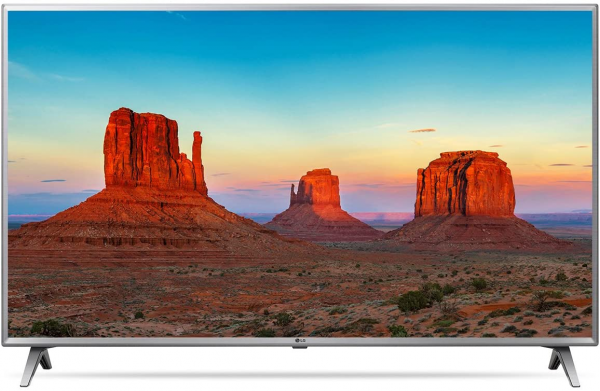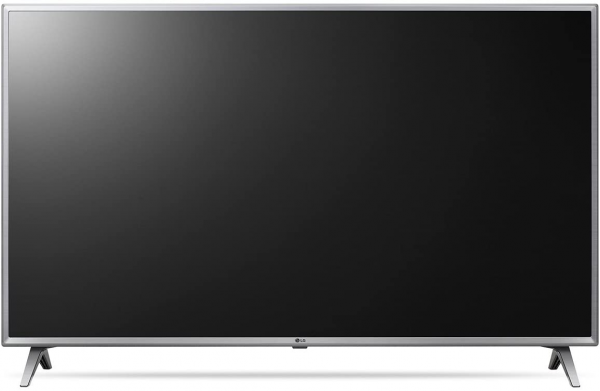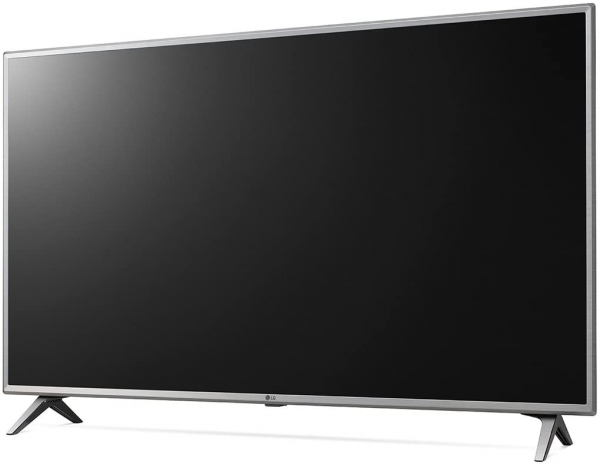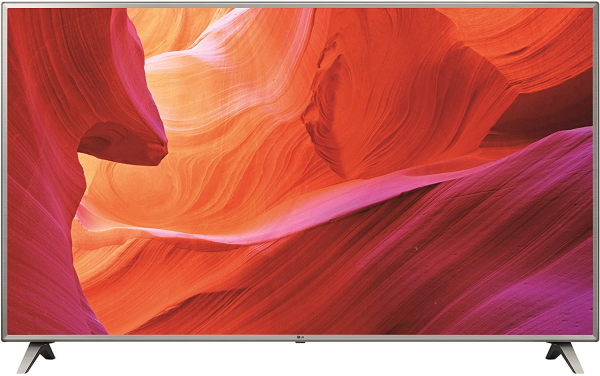LG
LG 43UK6500: a very average 43-inch Ultra HD IPS TV
Aprox. 409€
See specificationsThe LG 43UK6500 stands out from the competition by an IPS panel supposed to offer good viewing angles, at the expense of contrast. Let's see if this TV keeps its promises and can satisfy fans of video games and TV shows.
Positive points
Correct image quality in SDR.
Open viewing angles.
Delay in display worthy of that of a PC monitor.
Bad points
Contrast more than disappointing.
Very reduced brightness peak for HDR.
No microphone on the remote control.
No cable routing system.
Our review
Presentation
The Boulanger Ivry-sur-Seine store opened its doors to us to test the LG 43UK6500 TV, an entry-level Ultra HD model equipped with an IPS panel renowned for its viewing angles, but much less for its contrast. This television has a 43 inch (≈109 cm) panel displaying an Ultra HD resolution of 3,840 x 2,160 px. It has the WebOS 3.5 home interface and two 10-watt speakers.
The LG 43UK6500 is sold at a public price of € 550, but it is traded regularly for less than € 500. It is also available in versions 50 (50UK6500), 55 (55UK6500), 65 (65UK6500), 75 (75UK6500) and 86 inches (86UK6500) at the respective prices of € 600, € 700, € 1,100, € 1,400 and 2,700 €.

Image quality
The LG 43UK6500 operates an LCD panel using IPS (In-Plane Switching) technology. This technology improves viewing angles, at the expense of contrast, which is often very low. We have measured a fairly significant average loss of brightness of 70% on the 45 ° sides. On the other hand, there is no loss in the blacks, which allows this television to maintain the same contrast on the sides. Unfortunately, the latter is very, very limited.
IPS technology requires, the contrast is very limited since we noted a rate of only 770: 1. A value far removed from those reached by VA panels which always exceed 3000: 1 and sometimes even 5000: 1. Obviously, it also does not compare with the Oled. This poor native contrast could be compensated by a high brightness peak, but this is unfortunately not the case (see paragraph HDR).
In Cinema mode, the average delta E is measured at 3, a value below which the eye no longer perceives differences between the colors displayed on the screen and the ideal colors. This television is rather well calibrated at the factory and displays colors which can be considered as faithful to those sent by the source.
This LG TV handles gamma pretty well. The reference curve is relatively well followed and only the light grays are slightly blocked at the start of the curve.
The temperature curve is stable over the entire spectrum and the average temperature measured at 6,670 K is very close to the 6,500 K reference.
LG's Ultra Resolution scaling engine allows you to display Full HD content on this Ultra HD panel without distorting the original source too much. The treatment is very good, does not generate artifacts and does not smooth the flat areas too much. On the other hand, the motion compensation motor is a bit of a pain with this 50 Hz panel.

HDR
The LG 43UK6500 TV is compatible with HDR10 and HLG. With a maximum HDR signal of 10,000 cd / m², the Display Tone Mapping used by LG is far from perfectly following the reference curve in yellow. The TV is systematically below the curve. The peak in brightness is also very disappointing since we measured the maximum brightness at 310 cd / m², far from the 1,560 cd / m² of the LG 65SK9500 also equipped with an IPS panel or the 1,940 cd / m² of the Sony 65ZF9. The LG 43UK6500 is therefore not very comfortable with HDR content.
We also measure the color accuracy in HDR mode. It's rare enough to be highlighted, but we chose Vivid HDR mode, which produces fairer colors - if you can put it that way - than HDR Cinema mode. We have measured an average delta E at 9.7, far from the threshold of 3. These colors cannot be considered as faithful. For information, the average Delta E is approaching 20 in HDR Cinema mode, a shame!
The coverage of the Rec. 2020 and DCI-P3 color spaces is correct for an entry-level model. The LG 43UK6500 has 57% coverage of Rec.2020, when an Oled model reaches 70%; and it is limited to 79% of DCI-P3, when LG Oled TVs cover 93%.

Video games
The LG 43UK9500 displays the smallest delay to the display measured on a television in our laboratory (only 11 ms). The TV is the only one that can compete with PC monitors on this specific point. The delay in the display is thus limited to less than one image of delay relative to the source. Unfortunately, it's not the same story on the afterglow side. Measured at 19 ms, it is very present and the television is very largely behind the best LCD models which go down to 11 ms, like the Sony 65ZF9 or the Samsung 65Q9F. Oled models are always unbeatable with a remanence time of less than 1 ms.
We assess the quality of color reproduction in game mode, or at least with an option that reduces the delay in display. This LG TV is far from producing true colors. In SDR game mode, it displays a Delta E of 9.7 while in HDR mode, the colors are a little more accurate with a Delta E of 8.7. You will notice that the colors are more accurate in HDR game mode than in HDR cinema mode. In SDR, it is possible to find a more faithful image by adjusting the temperature on W45. The Delta E then returns to 3.6.

Clouding
The use of a Direct Led backlight system limits the risks of clouding, but this defect can still appear if the light distribution filter is damaged during transport. We did not find a banding problem. The homogeneity of the brightness on the screen is good and the average difference is measured at 10% on this 43 inch screen.
Ergonomics
The LG 43UK6500 sports a very sober design. LG uses an imitation aluminum plastic which gives a premium side to this television. The feet are offset, so you need a fairly large TV unit.
The imitation aluminum plastic used by LG is rather of good quality and manages to create an illusion. The edges of the screen are quite thick, but this is quite common on 43-inch models.
With its Direct-Led backlighting system, the LG 43UK6500 is thicker than an Edge-Led or Oled TV. It is 8.6 cm thick, but the dimensions on the TV stand are linked to the depth of the legs, which are limited to 22 cm here.
All of the connectors are distributed over several locations at the rear. There is no cable routing system, even simplified as on some Samsung or Sony models.
The connection of the LG 43UK9500 is quite complete. It consists of four HDMI 2.0b inputs, two USB ports, an Ethernet port, an optical digital audio output, a composite / YUV input, a PCMCIA (CI + Common Interface) port, a rake antenna connector and a satellite connector. It has a DVB-T / T2 (TNT), DVB-S / S2 (satellite) and DVB-C (cable) tuner. It also has 802.11a / b / g / n Wi-Fi and Bluetooth, but it does not offer a headphone output.
The WebOS system is pleasant to use. The main applications are available (Netflix, YouTube, Pluzz, MyTF1, Google Play Films or Deezer), launch quickly and remain in memory for a rapid recovery. This year, LG adds the AI ThinQ overlay which extends the number of available actions, but the absence of a microphone on the remote control completely curbs the contribution of the AI ThinQ.
Unlike the Android models, which take longer to start up for the first time, the LG TV and its WebOS system start up in less than 5 seconds. The extinction is instantaneous, and it takes less than 3 seconds for the exit from standby. On this point, the LG TV is clearly at the top of the basket.
The LG 43UK6500 comes with a very classic remote control which ignores Bluetooth connectivity and the integrated microphone. Light, it is pleasant to take in hand and the rubber buttons make no noise when pressed. It provides access to all of the TV's features and even offers multimedia keys as well as direct access to Netflix and Amazon Prime.
Audio
Tested in store, this TV could not go through our audio laboratory, but a brief listening shows that it is doing quite well. The two 10 W speakers produce sound that is clear enough and powerful enough to add sound to a living room. To get the most out of a good movie, it will be better to go through a dedicated audio system (soundbar, PC speakers, home cinema and even Bluetooth speakers).
Consumption
With a white calibrated at 150 cd / m², the LG 43UK6500 consumes 62 W on our test pattern, ie a relative consumption of 122 W / m². This television consumes much more than the Edge-Led LCD models such as the Sony KD-65XE8505, record holder in the category with its 56 W / m². It also consumes more than the Samsung QE65Q9FNAT which is content with 75 W / m² despite the use of a 480-zone Full Led backlight system.
Conclusion
The LG 43UK6500 delivers a fairly well calibrated SDR image, but that's it. The open angles can satisfy those who need a wide field of vision around the television, but the latter will be limited to viewing TV broadcasts. Lovers of video games (too high afterglow) and cinema (low contrast) will go their way.
Specifications

